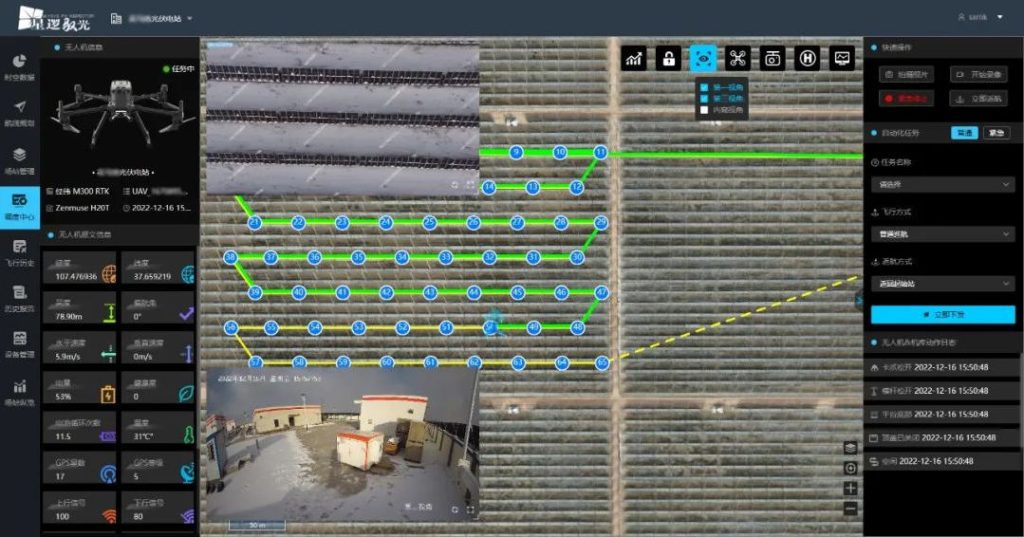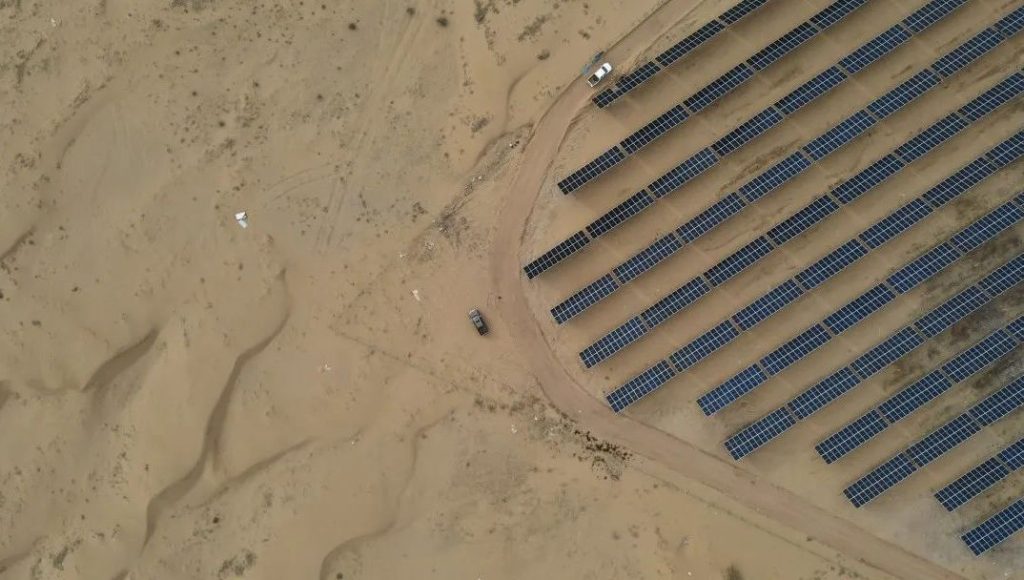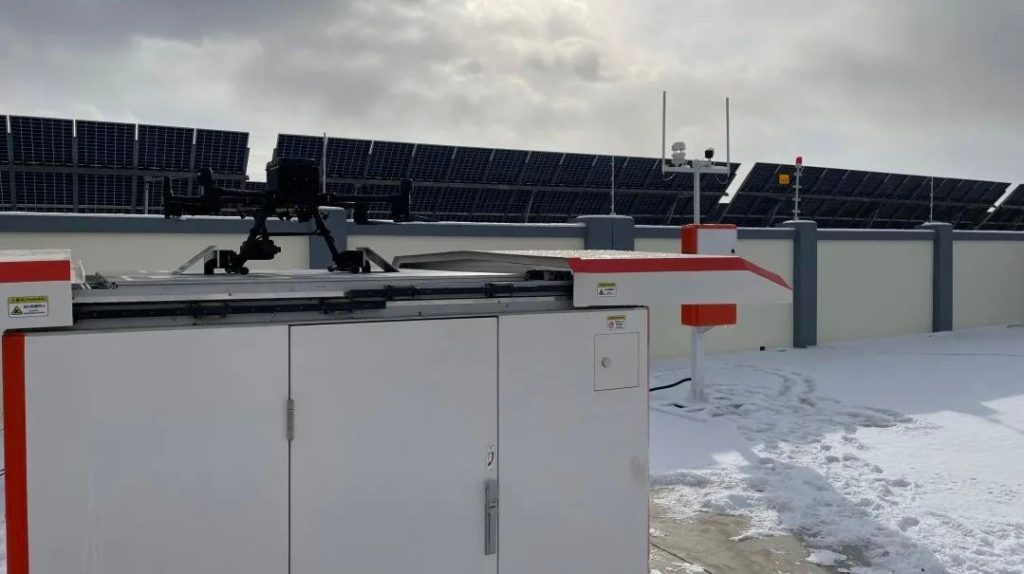
A CM Venture portfolio company, SKYSYS, has launched its official PV Inspector AI operations at a solar panel farm (PV power station) near Shaanxi, China.
Photovoltaic (PV) = solar energy
PV power station = solar farm
PV panel = solar panel
Located at the crossroads of Inner Mongolia, Ningxia and Shaanxi provinces, the PV power station, with its thousands of solar panels, is constantly exposed to shifting sands, weather changes and strong desert sun.
To begin with, it’s located in a unique area with very challenging weather. In spring, it’s warm and dry, with minimal rain. In winter, it faces severe cold and snowfall. The constant assault of wind, sand and snow on the panels affects the power generation efficiency of the PV panels. Having the massive PV power station generate energy from the sun at maximum efficiency is a large-scale challenge, as maintenance hurdles are high.

To meet the demands of the 300MW PV power station, the entire area – covered in PV panels – needs to be surveyed and monitored to keep the energy generation efficiency at its maximum. SKYSYS has developed a hybrid ‘drone + hangar + PV station’ operations and ‘maintenance management center + SKYSYS PV AI system’, creating an all-in-one solution where the air, ground and cloud works together.

Perfecting power generation efficiency
Due to its enormous size and scale, PV power stations face multiple challenges when trying to maintain maximum operational efficiency. Without an ‘eye in the sky’, ops and on-ground maintenance personnel have difficulties identifying or finding problems on the PV panels. In some cases, missing a fault leads to short circuits or fire, so dealing with PV panel problems on-time and on-site is about preventing hazards.
Since PV station fields are usually vast, with complex terrains, exposed to wind and sand constantly, and naked to extreme weather, relying on manpower alone to conduct solar farm inspections isn’t realistic.
The digital transformation of PV power stations is also a complex and expensive affair, as data collection is difficult, and maintenance efficiency is generally low. The big data that PV power stations require is very hard to collect from a macro level.
The SKYSYS PV AI solution is key to the digital transformation PV power stations seek. It’s easy-to-manage and operate, simple to integrate, and provides a macro POV to support its operations and maintenance.
The total solution to maximize solar panel efficiency
The PV power station’s total area is 7,108 acres, with a power output of 300MW.
SKYSYS smart inspection drones are housed in an automated all-in-one drone hangar. Aside from being a ‘drone base’, it also integrates automated battery charging and swaps, as well as wireless connectivity through radio and mobile signals to send/receive data. Location of the drone hangar is based on specific project requirements and wireless coverage. With an AI-driven intelligent flightpath, SKYSYS drones can regularly stream coverage of the entire PV station area to provide constant updates and reduce the need for physical inspections.
The SKYSYS hangar-based smart drone system isn’t affected by complex terrains, such as the Loess Plateau, where this PV power station is built. The automated all-in-one drone hangar serves as ‘drone base’ that combines fast battery charging, automatic battery swaps, temperature/humidity sensors, data collection and navigation guidance. All SKYSYS drone hangars feature high-strength stainless steel and magnesium-aluminum alloy external frames, which are fully rain and dust-proof (rated IP54), to cope with all-weather conditions, from severe cold, extreme heat, winds, sand, rain, and snow.
Since SKYSYS autonomous drones are remotely connected/controlled, flight paths are pre-planned through centralized cloud software. Target areas are covered by autonomous patrol/aerial surveillance by the drones, which can be programed to conduct regular inspections/collect information. Through wireless connectivity, users have access to live feeds of images/videos from the drones. The connection also provides remote storage for data, such as live status updates of the drone/flight. All this information, including hangar data, are uploaded to the cloud. This offers a well-structured way to manage and access the information to support operations.

Drones that can identify problems and help make decisions
When SKYSYS drones take to the sky to inspect PV power station panels, identifying PV panel defects is the top priority. Equipped with proprietary SKYSYS inspection software, the system uses machine learning and AI to intelligently identify, locate, and troubleshoot PV panel faults.

Equipped with light-sensitive and thermal imaging cameras and intelligent image-recognition software, SKYSYS smart drones can process complex and important image information to keep each PV panel performing at its best.
With thermal imaging, the observation of unusual hotspots on PV panels signals the possibility of component failure. Overheating, dirt accumulation, light blockage, damage/cracks/breakage, and more can be detected so preventive or correction action can be taken. For example, if a PV panel is obscured by an excessive accumulation of dust, an early warning message can be sent to maintenance personnel to take care of the problem, so the PV station’s solar energy generation can stay at optimum levels.
The SKYSYS PV Inspector AI system can quickly accurately identify, analyze and evaluate defects. With timely reporting of the critical data gathered from aerial inspections, the intelligent system can suggest actions to support operations or make decisions on maintenance. The accuracy of the fault detection rate of PV modules is over 90%.
Relied on around the world
Today, SKYSYS is depended on PV stations in China and overseas. Our smart drone systems have taken to the skies to support the operations and maintenance of over 30 PV stations, covering a combined 17,00 acres and delivering a nearly 800 MW to cities and industries.

The launch of the 300MW PV station in Shaanxi has provided a valuable opportunity for SKYSYS to apply its technology and service on a large scale.
SKYSYS will continue to stand by its dual-carbon offset strategy, through the intelligent use of drones in the renewable energy field. This is part of an effort in which an intelligent, autonomous, and smart inspection system can greatly aid our world achieve its precious ecology and economy goals